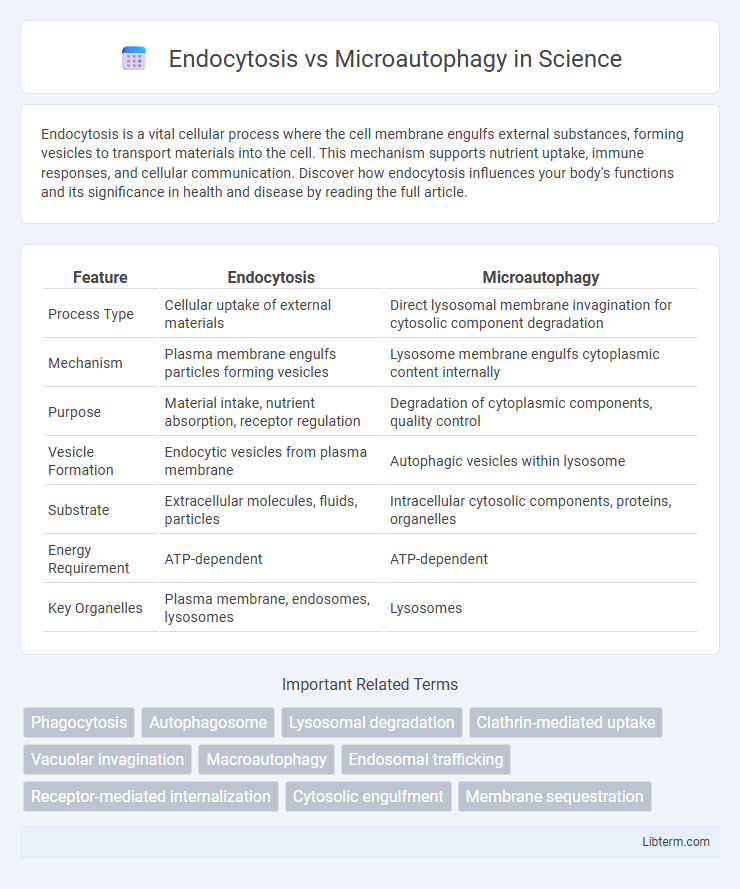Endocytosis is a vital cellular process where the cell membrane engulfs external substances, forming vesicles to transport materials into the cell. This mechanism supports nutrient uptake, immune responses, and cellular communication. Discover how endocytosis influences your body's functions and its significance in health and disease by reading the full article.
Table of Comparison
| Feature | Endocytosis | Microautophagy |
|---|---|---|
| Process Type | Cellular uptake of external materials | Direct lysosomal membrane invagination for cytosolic component degradation |
| Mechanism | Plasma membrane engulfs particles forming vesicles | Lysosome membrane engulfs cytoplasmic content internally |
| Purpose | Material intake, nutrient absorption, receptor regulation | Degradation of cytoplasmic components, quality control |
| Vesicle Formation | Endocytic vesicles from plasma membrane | Autophagic vesicles within lysosome |
| Substrate | Extracellular molecules, fluids, particles | Intracellular cytosolic components, proteins, organelles |
| Energy Requirement | ATP-dependent | ATP-dependent |
| Key Organelles | Plasma membrane, endosomes, lysosomes | Lysosomes |
Introduction to Cellular Uptake Mechanisms
Endocytosis is a cellular uptake mechanism where cells engulf extracellular materials through the invagination of the plasma membrane, forming vesicles that transport substances into the cell. Microautophagy involves the direct engulfment of cytoplasmic components by lysosomes through membrane invagination, facilitating the degradation and recycling of intracellular materials. Both processes are essential for maintaining cellular homeostasis, with endocytosis primarily targeting external substances and microautophagy focusing on internal cellular components.
Defining Endocytosis: Key Concepts
Endocytosis is a cellular process enabling the internalization of extracellular materials through membrane invagination and vesicle formation. This mechanism facilitates the uptake of nutrients, signaling molecules, and pathogens, maintaining cellular homeostasis and communication. Unlike microautophagy, which involves direct lysosomal engulfment of cytoplasmic components, endocytosis specifically targets external substances for transport into the cell.
Overview of Microautophagy
Microautophagy is a cellular process in which the lysosome directly engulfs cytoplasmic components by invaginating its membrane, enabling the degradation of damaged organelles and proteins. Unlike endocytosis, which involves the internalization of extracellular materials through vesicle formation at the plasma membrane, microautophagy selectively targets intracellular constituents for recycling. This lysosome-driven mechanism plays a crucial role in maintaining cellular homeostasis and responding to nutrient stress by degrading and recycling cytosolic components.
Biological Significance of Endocytosis
Endocytosis plays a crucial role in cellular homeostasis by enabling the internalization of extracellular molecules, nutrients, and membrane receptors, facilitating signal transduction and nutrient uptake. It contributes to immune responses through pathogen recognition and removal, as well as receptor-mediated endocytosis that regulates cell surface receptor density. Endocytosis's biological significance extends to maintaining plasma membrane composition and supporting intracellular trafficking essential for cellular metabolism and communication.
Functional Roles of Microautophagy
Microautophagy functions in the direct engulfment of cytosolic components by lysosomes, facilitating intracellular nutrient recycling and organelle turnover. Unlike endocytosis, which primarily manages extracellular material uptake and membrane trafficking, microautophagy ensures maintenance of cellular homeostasis through selective degradation of damaged proteins and organelles. This process plays a critical role in cellular adaptation to stress and nutrient deprivation by regulating metabolic balance and proteostasis.
Molecular Mechanisms: Endocytosis vs Microautophagy
Endocytosis involves the invagination of the plasma membrane to internalize extracellular molecules through clathrin-coated vesicles or caveolae, mediated by adaptor proteins and dynamin GTPases. Microautophagy is characterized by the direct engulfment of cytosolic components via lysosomal membrane invagination, regulated by autophagy-related (ATG) proteins and ESCRT complexes. While endocytosis primarily targets extracellular material, microautophagy selectively degrades intracellular substrates, reflecting distinct molecular machinery and vesicle formation processes.
Cellular Pathways and Compartments Involved
Endocytosis is a cellular process involving the invagination of the plasma membrane to internalize extracellular materials into endosomes, which then traffic to lysosomes for degradation. Microautophagy directly engulfs cytoplasmic components through lysosomal membrane invagination, bypassing the need for vesicle formation from the plasma membrane. Both pathways converge at the lysosome but employ distinct membrane dynamics and organelle compartments for cargo delivery and degradation.
Comparative Analysis: Endocytosis vs Microautophagy
Endocytosis involves the cellular uptake of extracellular materials via vesicle formation at the plasma membrane, primarily serving in nutrient absorption and receptor internalization, whereas microautophagy is a lysosomal degradation pathway that engulfs cytosolic components directly through lysosomal membrane invagination. Endocytosis is characterized by clathrin-mediated or caveolin-dependent mechanisms facilitating selective cargo entry, while microautophagy is non-selective or selective for removing damaged organelles and proteins within the cell. Both processes contribute to cellular homeostasis but differ in origin, molecular machinery, and target substrates.
Physiological and Pathological Implications
Endocytosis facilitates nutrient uptake and receptor regulation critical for cellular homeostasis, while microautophagy maintains organelle quality by direct lysosomal engulfment, playing essential roles in cellular metabolism and stress responses. Dysregulation of endocytosis is linked to neurodegenerative diseases such as Alzheimer's and cancer progression due to altered signaling pathways, whereas impaired microautophagy contributes to protein aggregation disorders and metabolic syndromes through defective autophagic clearance. Both processes are vital in modulating immune responses and cellular adaptation, with their dysfunction leading to pathological states characterized by inflammation and cellular toxicity.
Summary and Future Research Directions
Endocytosis and microautophagy are cellular processes that facilitate the internalization and degradation of extracellular and intracellular materials, respectively, with endocytosis primarily involving vesicle formation from the plasma membrane and microautophagy characterized by direct lysosomal membrane invagination. Emerging research focuses on elucidating the molecular mechanisms distinguishing these pathways, their roles in cellular homeostasis, and their implications in diseases such as neurodegeneration and cancer. Future studies aim to leverage advanced imaging and molecular techniques to explore regulatory networks, potential therapeutic targets, and the interplay between these processes in maintaining cellular function and response to environmental stress.
Endocytosis Infographic

 libterm.com
libterm.com